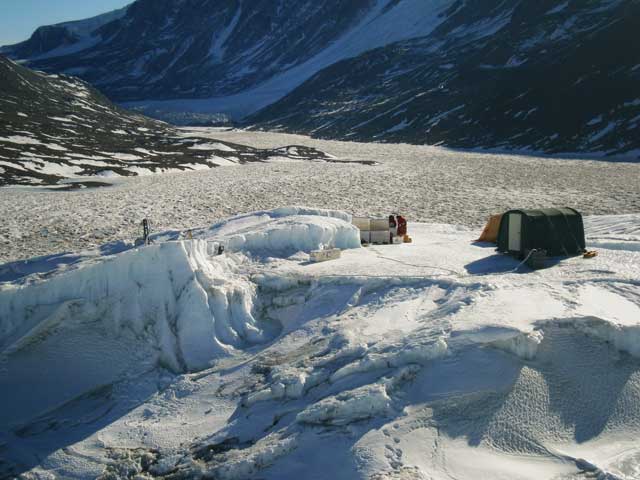|
Page 3/3 - Posted February 21, 2014
Geophysics work helps pinpoint location of subglacial reservoir, conduitMeanwhile, U.S. colleagues Erin Pettit Pettit used ground-penetrating radar to identify anomalies in the ice below the surface of the glacier for where there might be a channel. Tulaczyk then deployed strings of thermometers into four boreholes above the area that Pettit identified through radar analysis. The thermometers are capable of detecting heat fluxes in the ice. Tulaczyk explained that the brine, which remains in liquid form despite being minus 6 degrees Celsius, partly freezes as it rises to the surface through the minus 15-degree ice. That releases a tremendous amount of heat. How much heat? Based on preliminary measurements from the thermometer strings, which will collect data for about a year, the heat flux from freezing is about 20 times higher than geothermal sources. It would be the equivalent of a 500-degree rise in temperature in a thousand meters of ice. 
Photo Credit: Lars Jensen
A helicopter flies the SkyTEM transmitter loop through the McMurdo Dry Valleys.
“This is an extremely deep temperature gradient,” Tulaczyk said. “That’s the signature of a lot of freezing. “It takes an unusual set of conditions to squeeze water out to the surface through such cold ice,” he added. “It shouldn’t exist. It shouldn’t be there. But it is there.” Previous geophysical surveys in 2004 of Taylor Glacier have identified a possible source or reservoir about 5.5 kilometers up the glacier using ice-penetrating radar. In 2010, Mikucki and colleagues teamed with Danish company SkyTEM Surveys Employing a helicopter to fly a huge transmitter loop around the McMurdo Dry Valleys, SkyTEM uses a “transient electromagnetic method” to create magnetic fields that penetrate into the ground. The magnetic field will last longer through a good conductor like seawater versus one with low conductivity, or high resistivity, such as ice. The SkyTEM data also found highly conductive material in the same location as the 2004 survey. “It appears that this method works pretty well and it’s revealing another line of evidence that below Taylor Glacier is pretty significant conductive material,” Mikucki said. Scientists like Mikucki and Tulaczyk are only now beginning to understand just how diverse life is in the harshest of climates. Both are also principal investigators on the Whillans Ice Stream Subglacial Access Research Drilling (WISSARD) “They are different, but why wouldn’t a whole continent be patchy and different in its ecosystems? Just because it’s covered by ice you wouldn’t expect it to be the same,” Mikucki said. NSF-funded research in this article: Jill Mikucki, University of Tennessee in Knoxville, Award No. 1144178 |



For USAP Participants |
For The Public |
For Researchers and EducatorsContact UsNational Science FoundationOffice of Polar Programs Geosciences Directorate 2415 Eisenhower Avenue, Suite W7100 Alexandria, VA 22314 Sign up for the NSF Office of Polar Programs newsletter and events. Feedback Form |


